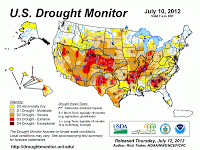 The USDA has announced improvements to its disaster designation process that will deliver faster and more flexible aid to farmers and ranchers. The new revisions to Secretarial disaster designation procedures are expected to decrease processing time for devastated counties by 40 percent. Also, as a result of the revisions, 996 counties in the United States will be classified as natural disaster areas. If USDA requirements are met, all farmers and ranchers residing in these areas will be eligible for low interest emergency loans.
The USDA has announced improvements to its disaster designation process that will deliver faster and more flexible aid to farmers and ranchers. The new revisions to Secretarial disaster designation procedures are expected to decrease processing time for devastated counties by 40 percent. Also, as a result of the revisions, 996 counties in the United States will be classified as natural disaster areas. If USDA requirements are met, all farmers and ranchers residing in these areas will be eligible for low interest emergency loans.
 Due to ongoing severe drought conditions, the U.S. Department of Agriculture (USDA) classified 39 additional counties as disaster areas. In total, 1, 297 counties across 29 states are eligible for drought aid. According to the government statistics, 60 percent of the lower 48 states are now affected by drought conditions. Also, as a result of the dry heat, corn and soybean prices have soared. Experts expect the rise in grain prices to cause an increase in meat and poultry prices, as well.
Due to ongoing severe drought conditions, the U.S. Department of Agriculture (USDA) classified 39 additional counties as disaster areas. In total, 1, 297 counties across 29 states are eligible for drought aid. According to the government statistics, 60 percent of the lower 48 states are now affected by drought conditions. Also, as a result of the dry heat, corn and soybean prices have soared. Experts expect the rise in grain prices to cause an increase in meat and poultry prices, as well.
It has been nearly a decade since New York City’s last family farm closed. In the last several years, determined farmers have transformed the state’s agriculture scene. Today, South Bronx, New York is the home of America’s largest and most successful rooftop farm. City officials are raving about the new farm operations. Rooftop farms are expected to aid in sewage issues by capturing gallons of storm water, alleviating pressure on the sewer system. The aerial farms will also help reduce greenhouse gas emissions because harvesting produce in the boroughs does not require much truck transport. There are, of course, some challenges facing rooftop farmers, like finding a roof strong enough to support their crops. However, farmers are optimistic as are the many for-profit companies that are investing in aerial farms now more than ever.
Recent studies reveal a shortage in young veterinarians willing to care for farm animals. Several students studying to become vets prefer city jobs, where the pay is steady and the work more glamorous. The American Veterinary Medical Association reports that only 17 percent of all veterinarians work with farm animals. In King County, Seattle that averages to one vet for every 1,800 animals. The association notes that the lack of veterinarians will lead to less surveillance of diseased animals coming into the country. The federal government has established a three-year program, with a pay-off of $25,000 per year, for new veterinarians working on rural farms. Federal officials and agriculturists hope that this program will produce a new wave of veterinarians who are willing to service food-supply animals.
Map image is a work of the National Oceanic and Atmospheric Administration, in the public domain.

